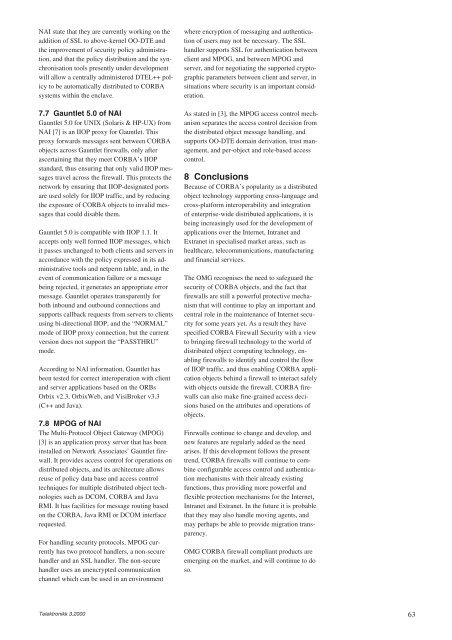Security - Telenor
Security - Telenor
Security - Telenor
Create successful ePaper yourself
Turn your PDF publications into a flip-book with our unique Google optimized e-Paper software.
NAI state that they are currently working on the<br />
addition of SSL to above-kernel OO-DTE and<br />
the improvement of security policy administration,<br />
and that the policy distribution and the synchronisation<br />
tools presently under development<br />
will allow a centrally administered DTEL++ policy<br />
to be automatically distributed to CORBA<br />
systems within the enclave.<br />
7.7 Gauntlet 5.0 of NAI<br />
Gauntlet 5.0 for UNIX (Solaris & HP-UX) from<br />
NAI [7] is an IIOP proxy for Gauntlet. This<br />
proxy forwards messages sent between CORBA<br />
objects across Gauntlet firewalls, only after<br />
ascertaining that they meet CORBA’s IIOP<br />
standard, thus ensuring that only valid IIOP messages<br />
travel across the firewall. This protects the<br />
network by ensuring that IIOP-designated ports<br />
are used solely for IIOP traffic, and by reducing<br />
the exposure of CORBA objects to invalid messages<br />
that could disable them.<br />
Gauntlet 5.0 is compatible with IIOP 1.1. It<br />
accepts only well formed IIOP messages, which<br />
it passes unchanged to both clients and servers in<br />
accordance with the policy expressed in its administrative<br />
tools and netperm table, and, in the<br />
event of communication failure or a message<br />
being rejected, it generates an appropriate error<br />
message. Gauntlet operates transparently for<br />
both inbound and outbound connections and<br />
supports callback requests from servers to clients<br />
using bi-directional IIOP, and the “NORMAL”<br />
mode of IIOP proxy connection, but the current<br />
version does not support the “PASSTHRU”<br />
mode.<br />
According to NAI information, Gauntlet has<br />
been tested for correct interoperation with client<br />
and server applications based on the ORBs<br />
Orbix v2.3, OrbixWeb, and VisiBroker v3.3<br />
(C++ and Java).<br />
7.8 MPOG of NAI<br />
The Multi-Protocol Object Gateway (MPOG)<br />
[3] is an application proxy server that has been<br />
installed on Network Associates’ Gauntlet firewall.<br />
It provides access control for operations on<br />
distributed objects, and its architecture allows<br />
reuse of policy data base and access control<br />
techniques for multiple distributed object technologies<br />
such as DCOM, CORBA and Java<br />
RMI. It has facilities for message routing based<br />
on the CORBA, Java RMI or DCOM interface<br />
requested.<br />
For handling security protocols, MPOG currently<br />
has two protocol handlers, a non-secure<br />
handler and an SSL handler. The non-secure<br />
handler uses an unencrypted communication<br />
channel which can be used in an environment<br />
Telektronikk 3.2000<br />
where encryption of messaging and authentication<br />
of users may not be necessary. The SSL<br />
handler supports SSL for authentication between<br />
client and MPOG, and between MPOG and<br />
server, and for negotiating the supported cryptographic<br />
parameters between client and server, in<br />
situations where security is an important consideration.<br />
As stated in [3], the MPOG access control mechanism<br />
separates the access control decision from<br />
the distributed object message handling, and<br />
supports OO-DTE domain derivation, trust management,<br />
and per-object and role-based access<br />
control.<br />
8 Conclusions<br />
Because of CORBA’s popularity as a distributed<br />
object technology supporting cross-language and<br />
cross-platform interoperability and integration<br />
of enterprise-wide distributed applications, it is<br />
being increasingly used for the development of<br />
applications over the Internet, Intranet and<br />
Extranet in specialised market areas, such as<br />
healthcare, telecommunications, manufacturing<br />
and financial services.<br />
The OMG recognises the need to safeguard the<br />
security of CORBA objects, and the fact that<br />
firewalls are still a powerful protective mechanism<br />
that will continue to play an important and<br />
central role in the maintenance of Internet security<br />
for some years yet. As a result they have<br />
specified CORBA Firewall <strong>Security</strong> with a view<br />
to bringing firewall technology to the world of<br />
distributed object computing technology, enabling<br />
firewalls to identify and control the flow<br />
of IIOP traffic, and thus enabling CORBA application<br />
objects behind a firewall to interact safely<br />
with objects outside the firewall. CORBA firewalls<br />
can also make fine-grained access decisions<br />
based on the attributes and operations of<br />
objects.<br />
Firewalls continue to change and develop, and<br />
new features are regularly added as the need<br />
arises. If this development follows the present<br />
trend, CORBA firewalls will continue to combine<br />
configurable access control and authentication<br />
mechanisms with their already existing<br />
functions, thus providing more powerful and<br />
flexible protection mechanisms for the Internet,<br />
Intranet and Extranet. In the future it is probable<br />
that they may also handle moving agents, and<br />
may perhaps be able to provide migration transparency.<br />
OMG CORBA firewall compliant products are<br />
emerging on the market, and will continue to do<br />
so.<br />
63

















